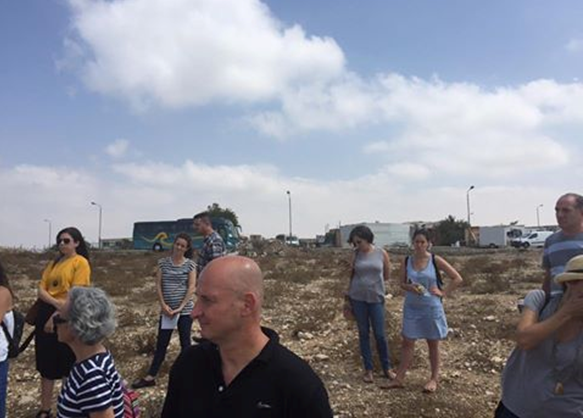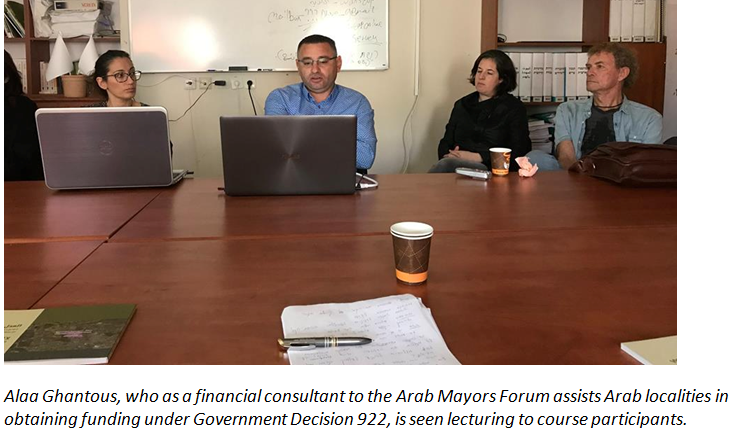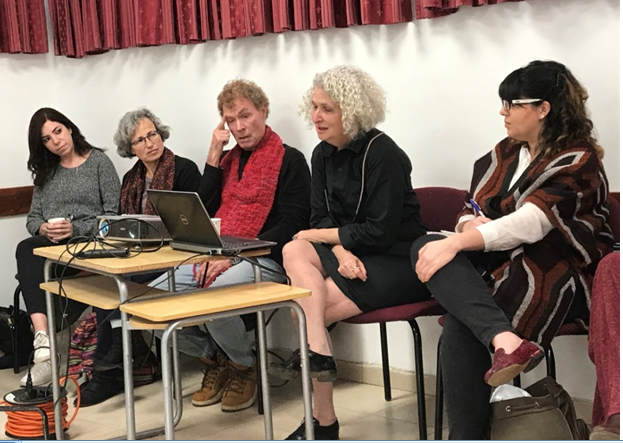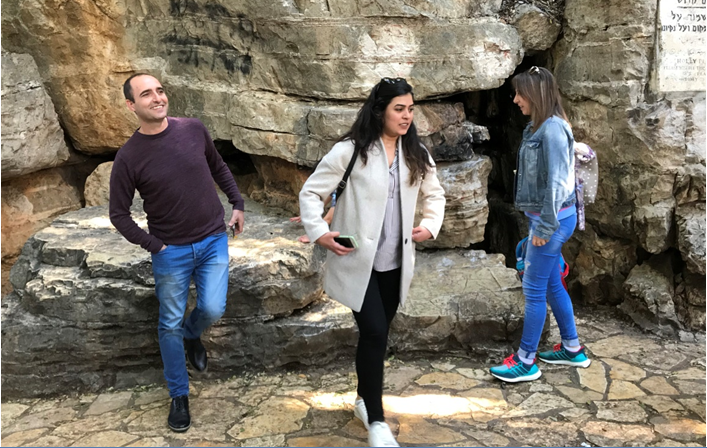Publishing date: 06/08/2018


Final Report 2017-18
The course is given by the School for Peace (SFP) in full partnership with the Arab Center for Alternative Planning in Eilabun. We spent three months recruiting new participants, assisted by graduates of the previous course and aided by the positive reputation the course has already attained. We had no difficulty recruiting 27 architects and urban planners: 15 Jews and 12 Arabs. Women (15) outnumber men (12) in the new group. All the participants are professionals: 6 civil engineers, 15 architects, 3 urban planners, 2 environmentalist planners, and 2 lawyers who specialize in planning-related work. The participants come from all over Israel, including the Bedouin city of Rahat in the south and Nazareth in the north. Several participants are highly experienced architects who work with the Arab population. Sessions take place at Wahat al-Salam – Neve Shalom (WASNS) and at the Arab Center for Alternative Planning (ACAP) in Eilabun.
Initial 3-day workshop
We began the course with a 3-day workshop at WASNS on March 23-25, 2017. The workshop focused on intensive dialogue around the Arab-Jewish conflict, using the SFP working method. Course coordinators Dr. Nava Sonnenschein, SFP Director, and Samer Swaid, Director of ACAP, facilitated the workshop. Over three days, participants discussed a wide range of relevant issues, including government restrictions impeding expansion of Arab villages and towns; various types of planning-related and other discrimination; disparities in budgetary resources available to Jewish and Arab jurisdictions; and the impact of the designated character of the State (Jewish, democratic, etc.).
Participants discussed the 1948 war and the issue of refugees. They also discussed the fears of the Jews, racism, the deterioration of democracy and the recent violent events in Israel and Palestine. In the evening we watched a film, “500 Dunam on the Moon”, directed by Rachel Leah Jones. The film tells the story of Ayn Hawd, a Palestinian village in what is now Israel that was captured and depopulated by Israeli forces during the 1948 war; in 1953 Marcel Janco, a Romanian painter and a founder of the Dada movement, helped transform the village into a Jewish artists' colony, renamed Ein Hod. The film stimulated an interesting discussion on the Nakba. The third and final day of the workshop featured a simulated negotiation addressing future relations between Jews and Arabs in Israel, focusing on three central issues – land, reconciliation, and the character of the State, following which each negotiating group presented the outcome of their negotiation process. This workshop enables participants to discuss some of the complex issues of the conflict on both an intellectual and emotional level and to reach a deeper understanding through candid dialogue with the ‘other’ side. For most of the Jewish participants, this is their first experience of the issues of discrimination and racism faced by the Arab community in dealing with national, regional, and local planning councils.
As part of the course, we organized a WhatsApp group to facilitate ongoing contact between participants in the intervals between meetings –generating a lot of action as participants continually update one another on events related to the course, their areas of interest, and activities being pursued around the country.
.PNG)

The second meeting of the group took place on May 5, 2017 in the north at the offices of the Arab Center for Alternative Planning (ACAP). Dr. Hanna Sweid, the Center’s founder, was the featured lecturer, speaking about the planning issues faced by Arab Palestinian society in Israel.

On June 9, 2017 we held the group’s third meeting, this one at WASNS. The session began with a bi-national dialogue, followed by a lecture by Open University Professor Mustafa Kabaha on the 1948 war and the Nakba. The lecture led to a serious discussion about the impact of the Nakba on the Palestinian people in general and specifically on the families of the participants. One participant shared the story of her family who lived in Biraam and how they were forced to become refugees. At this stage of the course, the group dialogue is becoming more in-depth and touching on sensitive personal issues.
Fourth meeting on the weekend of July 27-28, 2017
The weekend offered 2 days of activity. On Thursday, Dr. Enaya Banaa, chief engineer at the Wadi Ara Planning Committee, spoke about some of the planning-related challenges in Arab towns.
The next day, graduates of previous courses joined our group for the day. We were 50 participants all together. The group was divided into 4 subgroups to address ways to advance selected subjects of particular interest.
I. Planners Forum Group: This subgroup looked at strengthening the Arab Jewish Forum for Planners:
The group will devote itself to empowering and developing this newly emerging forum. The main challenge is distance: Most of the active Jews live in Tel Aviv, while most of the Arab planners are from the north. Discussions about how to integrate the participants despite this barrier of geography yielded a suggestion that meetings be conducted alternately in the north and in the center.
II. Forum to Promote Renewal and Urban Planning in Arab towns and villages. This subgroup looked at the current reality, in which the modernization sought by many Arab villages that have expanded into towns can threaten the survival of the historic “old town” section built along different, simpler lines. There was discussion of ideas about how development might be pursued equitably, without destroying the old village center.
The team has met once so far, and plans to continue next week. Some notes from its work:
Urban renewal in Arab society
The meaning of the term and its relevance for us:
- What spaces are relevant to renewal? Public space, private space, or a combination?
- Is empty-out-and-build, as an example of what happens in Jewish cities, relevant to an Arab city/town/village and, if so, what is the smallest unit to be addressed (family plots?).
- What is the yardstick for intervention? (A general plan? A pinpoint project?)
- Who are the partners, and how can they be engaged (trust building)?
What are the benefits of urban renewal:
- Physical: Developing and adapting the built space to the needs of today and of the foreseeable future...? Addressing the situation and planning from the standpoint of the social/community structure.
- Cultural: Community renewal that preserves the traditions, the heritage and the culture within the changes and the adaptations demanded for today’s society.
- Improvement of urban infrastructure.
- Economic: Density and building to saturation, raising land values for marketing purposes or establishing potential family needs for future building (density as an engine of urban renewal).
- Quality of life: Taking care of the public space, creating solutions for pedestrian / bicycle / automobile / traffic and public transportation.
- The fabric of living (mixed use): Residential / tourism / commercial / employment / public facilities.
How to achieve the intended benefits:
- Building a shared process with the community to formulate goals and benefits and modes of action for a particular space.
- Formal partners: Ministry of Construction and Housing, Prime Minister’s Office, local councils.
- Who are we? Defining the team and their roles, and rounding out the required expertise.
- Shared learning – seeking out academic knowledge on the subject.
- Statutory regularization.
- Defining yardsticks for success.
Looking for opportunities in the built space:
Planning potential:
- · Village core, state land as examples of a way for which there is no need today in its broadest sense, forests, etc.
- · Access roads to villages as a basis for modern mixed use urban development.
- · Intervention in focal points that generate change.
- · An existing fabric only partly addressed (holes in the fabric).
- · Identifying trends: a place where self-renewal has already begun, independently.
Social potential:
- · Existing community support system, strong community leadership.
- Economic potential:
- · Land values.
- · Size of the village or city, and location (role) in relation to neighboring towns.
III. Promoting more housing for young couples on private land in Arab localities: A third subgroup discussed a project to generate a business initiative in which owners of private land in Arab communities can invest in building for young couples and rent the buildings.
IV. Advancing the implementation of Government Decision 922 in Arab localities. This subgroup discussed how best to intervene together in this process. Right now there are budgets for planning designated for Arab localities but utilizing them demands professional knowledge that is lacking in the Arab local councils; this is a burning issue. The SFP and ACAP are looking for the right way to enable our program graduates to assist Arab local authorities in this matter.
.PNG)
.PNG)
Fifth meeting: The study tour to East Jerusalem / Al Quds, September 15, 2017.
The architects and urban planners went on an organized tour of Jerusalem for a close-up view of what the reality of discrimination and occupation in East Jerusalem means.
The tour was guided by Ir Amim and was eye-opening for our participants in terms of their understanding of the planning issues for Palestinians in East Jerusalem. For more data on that subject, please go to http://www.ir-amim.org.il/en/issues
After the tour, the group had lunch at the Notre Dame guest house and heard a lecture by Jerusalem City Council member Meir Margalit (from Meretz).
People said it was one of the highlights of the course.
(Photos follow.)


Sixth meeting: Workshop at ACAP, November 3, 2017.
At this workshop, held at the Arab Center for Alternative Planning in Eilabun, the day began with participants sharing their experiences from the East Jerusalem study tour. That session was very valuable for them and allowed them a chance to offer feedback about the program thus far. Participants said that the course is a very meaningful experience for them, and they would like the meetings to be held more frequently. They also suggested that at each meeting, one participant would come prepared to present a case study on a situation they are currently dealing with and be able to receive feedback and input from the others.
We then heard a lecture by financial consultant Alaa Ghantous, who talked about his own efforts, and joint efforts with others, to assemble plans to take optimal advantage of Government Decision 922 funding, and he reviewed all the factors that contributed to the success of those efforts.
Initially, he discussed the professional work and considerable efforts involved, among all parties concerned, to provide accurate professional data at their meetings. Secondly, he mentioned the joint work of all the relevant stakeholders – political parties, the Committee of Arab Local Authorities, and civil society organizations – as contributing factors in the success of this initiative. The overall approach was pragmatic, and pains were taken to insure, for example, that accurate data and precise information were available and presented at all government meetings. The timing of 922 is important, he said, because the Israeli government is currently anxious about falling global economic rankings by the OECD and realizes that if it does not deal with the problems of unemployment in Palestinian society, Israel’s position will deteriorate globally. This is part of the impetus now for cooperation on 922 funding and the progress it is intended to support.

On December 3, 2017 the group from the course met at WASNS. We began with a dialogue within the group. Next we heard a talk by Professor Oren Yiftachel on “the Regime of Land and its Nationalization and Privatization in Israel.” Afterwards we continued with dialogue in the group. Numerous interrelated issues arose that have to do with both planning and the political situation.
On January 5, 2018 we held a meeting in Eilabun. It began with a study tour to learn about the history of the village in the 1948 war and the Nakba. After the tour we heard a lecture by the Chair of the Joint List, MK Ayman Odeh. He spoke on challenges in Jewish Arab political cooperation and about Government Decision 922 and the difficulties of implementing it in reality. After lunching with MK Odeh, we continued our discussion. Participants offered feedback about how to improve the course, and suggested bringing case studies from their work to be addressed by the group.
.PNG)
On February 2, 2018 we held a meeting at the SFP at Neve Shalom/ Wahat al Salam. Three participants presented case studies and dilemmas from their work in the field. Architect Eli Weisberg presented a case, and architects Modi and Dafna presented a case from their work in the Druze village Daliat El Carmel. We also heard a lecture by Professor Ayala Ronel. She described a few of the projects she is working on that aim to change discriminatory planning policies in East Jerusalem, in Jisr az-Zarqa and in Wadi Ara. This meeting centered on practical consideration of planning issues vis-a-vis the Arab population. The participants were deeply engaged in the discussions.

On March 16-17, 2018 we held our concluding weekend session to end the course, at Peki’in in the northern Galilee. The gathering was very special, even magical. Peki’in is the village where Samer Swaid, who is co-facilitating the course with Nava Sonnenschein, grew up.
First we heard a panel that addressed planning for private land in Peki’in as an example of successful planning, with the participation of Mayor Swaid Swaid, who talked about planning in the community. Architect Ibrahim Dweiry spoke about a plan he worked to advance in Peki’in. Attorney and real estate appraiser Radi Nijam spoke about planning for the amalgamation and division of land in Arab towns. The Q&A session that followed was lively. The last two speakers were graduates of the first group to participate in the planning course. That evening, we dined in a local restaurant located in a cave.
The next day we enjoyed a fascinating tour of Peki’in led by Samer, showing us the breadth of cultural diversity in the community. We met with entrepreneur Grandma Jamila who created a boutique soap business in the village. We had another dinner in the restaurant in the cave and a midday lunch in the old mukhtar’s house, where we also celebrated having reached the conclusion of the course and received our certificates.





We then resumed the tour, and saw Yusif’s Bakery and the restored alleyways in the old village center, preserved thanks to efforts by architect Abed Yassin (a graduate of the first planners course). Finally we returned to our lodgings and sat down for two summary discussions, one of which focused on the structure of the course. Lihi and Dorit prepared a proposal for improving the course and we discussed it, after which each of the participants made a personal concluding statement. Among the important feedback we heard was that long intervals in the course schedule should be avoided, and that we should adhere very closely to the planned course outline. Participants expressed themselves in favor of launching a Phase B of the course, at a more advanced level.
Comments by participants
There were numerous worthwhile comments made by various course participants during the concluding discussion. A sampling:
On the structure of the course:
Participants mentioned the importance of the study tours as well as the importance of case study presentations which highlight real-world planning dilemmas. They suggested building the course more closely around such planning issues. They noted that the integration of planning content and the background of relevant political history is very important. They also noted the importance of involving decision-makers in the process. The program, some suggested, should be tightened up. Two participants proposed a Phase B sequel to the course just ending.
On their individual experience as participants:
M., a Jewish man, said: This is quite magical, what you have been able to do here. Most of those who began the course were there throughout, which is not a foregone conclusion. People showed up because it was positive for them. It’s an unusual success, and not to be taken for granted.
M., a Jewish woman, said: The course provides a rare opportunity for two sides to meet who almost never otherwise do. It opened a way for me to be able to cope with the situation in this country, instead of remaining in denial. I find myself addressing history, and the narratives. I discovered that I was more tolerant of difference than I’d realized My work with Bedouin communities now is coming from a place of not being afraid to address this subject.
M., a Jewish woman: The encounter was eye-opening, going into subjects to which I’d never been exposed before this, things I never knew about. To hear each person’s voice gave me a new perspective on the construction of the political space in which I was raised.
A., an Arab woman: I liked that I was exposed to places previously unknown to me. It gave me a way of looking forward and of accepting the other. I was exposed to lives different than my own. This led me to undertake initiatives in my own society.
R., an Arab woman: The course affected me as a human being. I have greater appreciation for my thinking, now. Professionally, I changed in a few ways. I began working at the Arab Center for Alternative Planning, doing work that is important for everyone. And from there, each person can grow, and with everyone’s small changes, all together it has an impact.
R., an Arab man: The course helped me contribute to the society we are creating in Haifa. We have a project there and I’m bringing things to it that I got here. I want to invite all of you to come and hear a discourse that you haven’t heard previously.
Ongoing Activism by the Arab Jewish Forum for Planners
Ophir Fichman and Ranin Odeh have undertaken the leadership of the Arab Jewish Forum for Planners. They assembled a steering committee that has met once in Haifa and once in Tel Aviv thus far. They wanted to publicize another petition to protest the pending demolition of [the unrecognized Negev Bedouin village of] Umm al Hiran, but the residents had been in negotiations with the government and, with no other choice, had already agreed to move to the nearby town of Hura. In June another gathering is to be held for all the graduates of SFP-ACAP planners courses, at which the organizers seek to have project planning expert Shahira Shalabi advise them on advancing their projects.
Alongside the ongoing development of the Arab Jewish Forum for Planners, another group is working on the challenges of urbanization and renewal in Arab villages. In that group there are eight planners from the second and third planners courses. Two of the planners presented a culture sensitive approach to the issue. Two meetings were held at WASNA to provide greater understanding of the issues involved and of the challenges in addressing them. Samer Swaid looked into which village we should visit as a basis for our discussions. After Kfar Qar’e was selected, we visited the village and talked with the deputy mayor and the village civil engineer. The group’s next step is to review the village’s master plan and then begin working jointly on an agreed agenda.